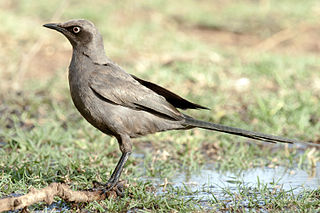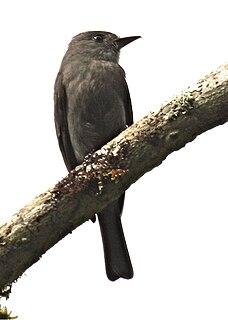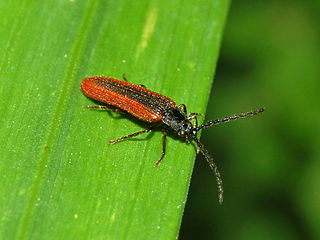
Bonitos are a tribe of medium-sized, ray-finned predatory fish in the family Scombridae – a family it shares with the mackerel, tuna, and Spanish mackerel tribes, and also the butterfly kingfish. Also called the Sardini tribe, it consists of eight species across four genera; three of those four genera are monotypic, having a single species each.

The sambar is a large deer native to the Indian subcontinent, southern China, and Southeast Asia that is listed as Vulnerable on the IUCN Red List since 2008. Populations have declined substantially due to severe hunting, insurgency, and industrial exploitation of habitat.

The unicolored jay is an Aphelocoma jay native to cloud forests of northwestern Central America and southern and southeastern Mexico, from central Honduras west to central Guerrero, southern Veracruz and extreme southern San Luis Potosí. It is apparently a basal member of its genus. At Montebello, Chiapas, it is a cooperative breeder.

The Antipodes parakeet or Antipodes Island parakeet is endemic to the Antipodes Islands of New Zealand, one of two parrot species found on the islands, and one of only five ground-dwelling parrots in the world. They are long-living birds that may live up to 10 years of age, but the introduction of mice that compete for food with them is a threat to their survival on the Antipodes Islands. Unusually for parrots, they sometimes prey upon other birds, a trait shared by another New Zealand parrot, the kea.

The Boridae are a small family of beetles with no vernacular common name, though recent authors have coined the name conifer bark beetles.
The short-furred Atlantic tree-rat or Wagner's Atlantic tree rat, is a spiny rat species from South America. It is found in Brazil.

The brown lanternshark or bristled lanternshark is a little-known species of deep-sea dogfish shark in the family Etmopteridae. It is found off Japan and New Zealand, and possibly also South Africa and Australia, typically deeper than 300 m (980 ft). This species can be distinguished from other lanternsharks by its coloration, which is a uniform dark gray or brown without the ventral surface being much darker and clearly delineated from the rest of the body. The brown lanternshark feeds on small bony fishes, cephalopods, and crustaceans. Reproduction is ovoviviparous, with females giving birth to 9–18 young. An unusually high proportion of individuals in Suruga Bay are hermaphrodites, with both male and female characteristics.
The Banggai crow is a member of the crow family from Banggai regency in the province of Central Sulawesi in Indonesia. It is listed as critically endangered by IUCN. It was feared extinct, but was finally rediscovered during surveys on Peleng Island off the southeast coast of Sulawesi by Indonesian ornithologist Mochamad Indrawan in 2007 and 2008.

The Sri Lankan sambar deer or Indian sambar deer is a subspecies of sambar deer that lives in India and Sri Lanka. This subspecies is one of the largest sambar deer species with the largest antlers both in size and in body proportions. Large males weight up to 270–280 kg. Sambar live in both lowland dry forests and mountain forests. Large herds of sambar deer roam the Horton Plains National Park, where it is the most common large mammal.

The ashy starling is a species of starling in the family Sturnidae. It is found in Kenya and Tanzania. It is alternatively placed in the genus Cosmopsarus or Spreo.

The pale blue flycatcher is a species of bird in the family Muscicapidae.

The uniform antshrike is a species of bird in the family Thamnophilidae. It is found in Colombia, Ecuador, and Peru. Its natural habitat is subtropical or tropical moist montane forests.

The brown-tailed mongoose, Malagasy brown-tailed mongoose, or salano is a species of mammal in the family Eupleridae. It is endemic to Madagascar. Its natural habitat is subtropical or tropical dry forests. It is threatened by habitat loss.

The Sambirano woolly lemur, also known as the Sambirano avahi or unicolor woolly lemur, is a species of woolly lemur native to western Madagascar.

Byturidae, also known as Fruitworms, is a very small family of beetles, in the suborder Polyphaga, comprising fewer than 20 species worldwide. The larvae of some species develop in fruits. Byturus unicolor affects species of Rubus and Geum.

Omalisidae are a very small family of beetles within the superfamily Elateroidea. Members of this beetle family have bioluminescent organs on the larvae. The most recent evidence indicates they are the sister group to a clade comprising the families Rhagophthalmidae and Phengodidae.
The Plain snake-eel is an eel in the family Ophichthidae. It was described by Charles Tate Regan in 1908. It is a marine, subtropical eel which is known from Algoa Bay, South Africa, in the southeastern Atlantic Ocean. Males can reach a maximum total length of 30 centimetres (12 in).
Hemilophini is a tribe of longhorn beetles of the Lamiinae subfamily.
Tetamauara is a genus of longhorn beetles of the subfamily Lamiinae, containing the following species:
Tetamauara retifera is a species of beetle in the family Cerambycidae. It was described by Waterhouse in 1880. It is known from Ecuador.















